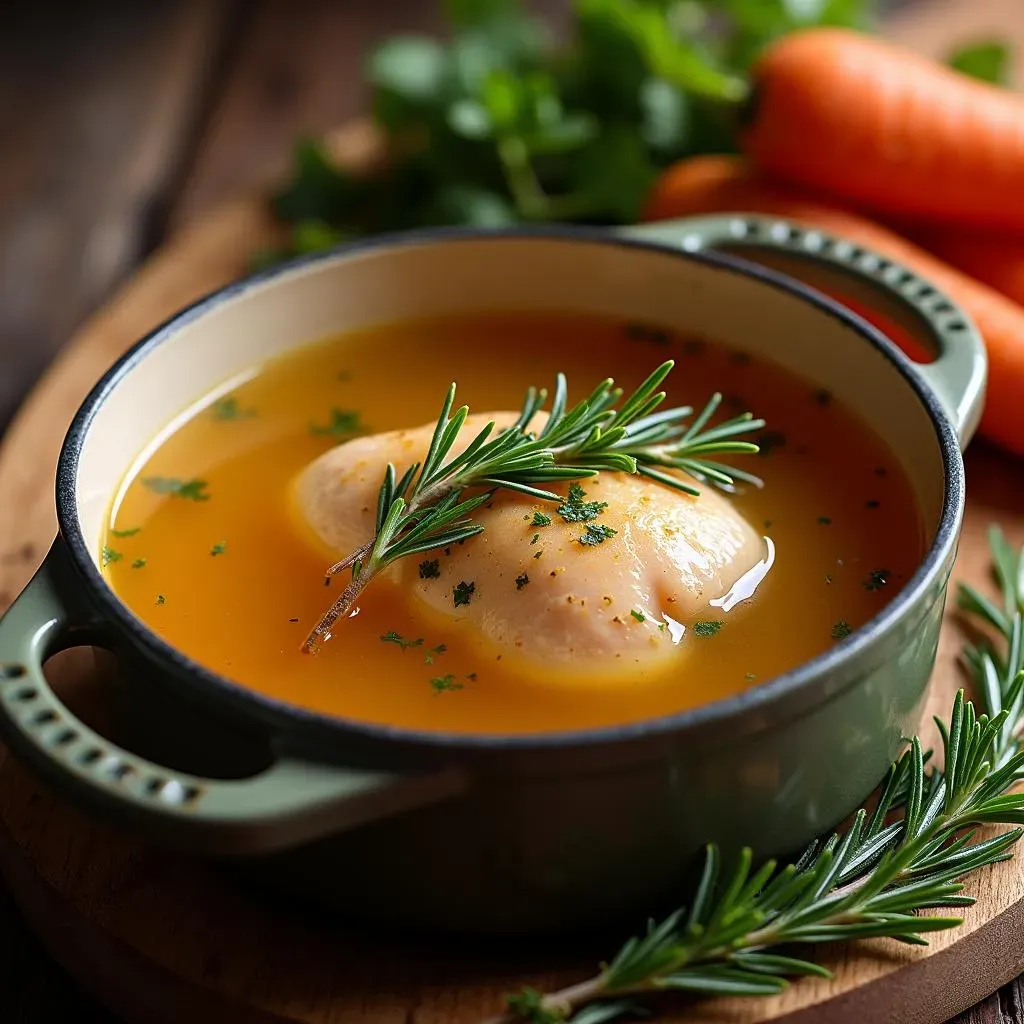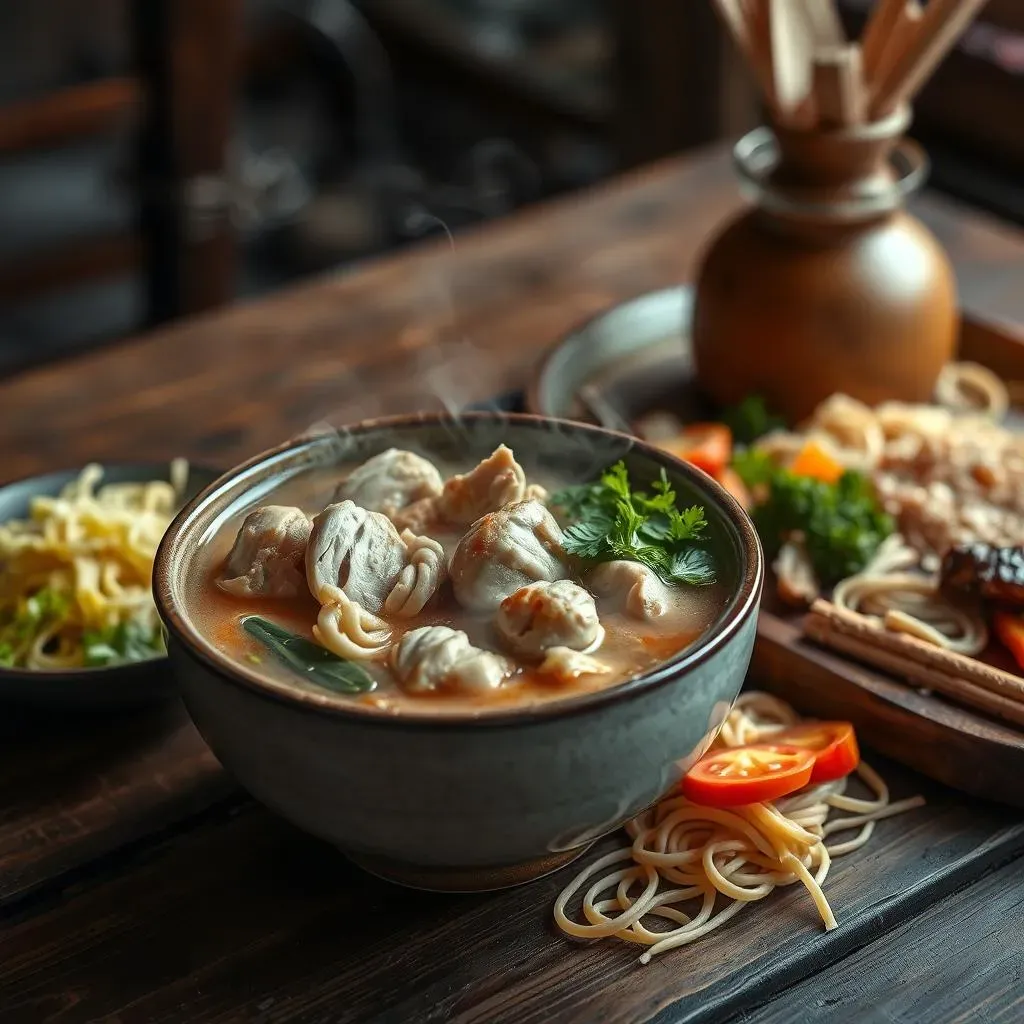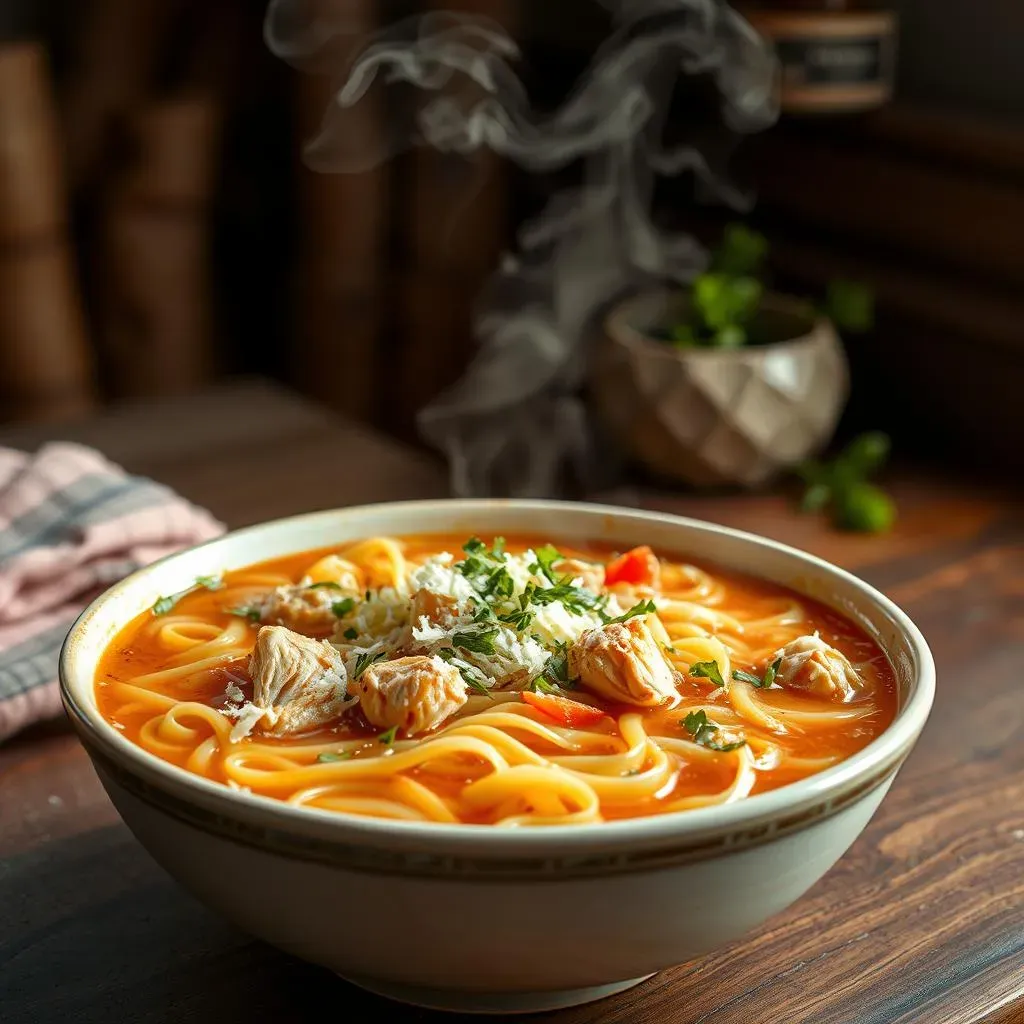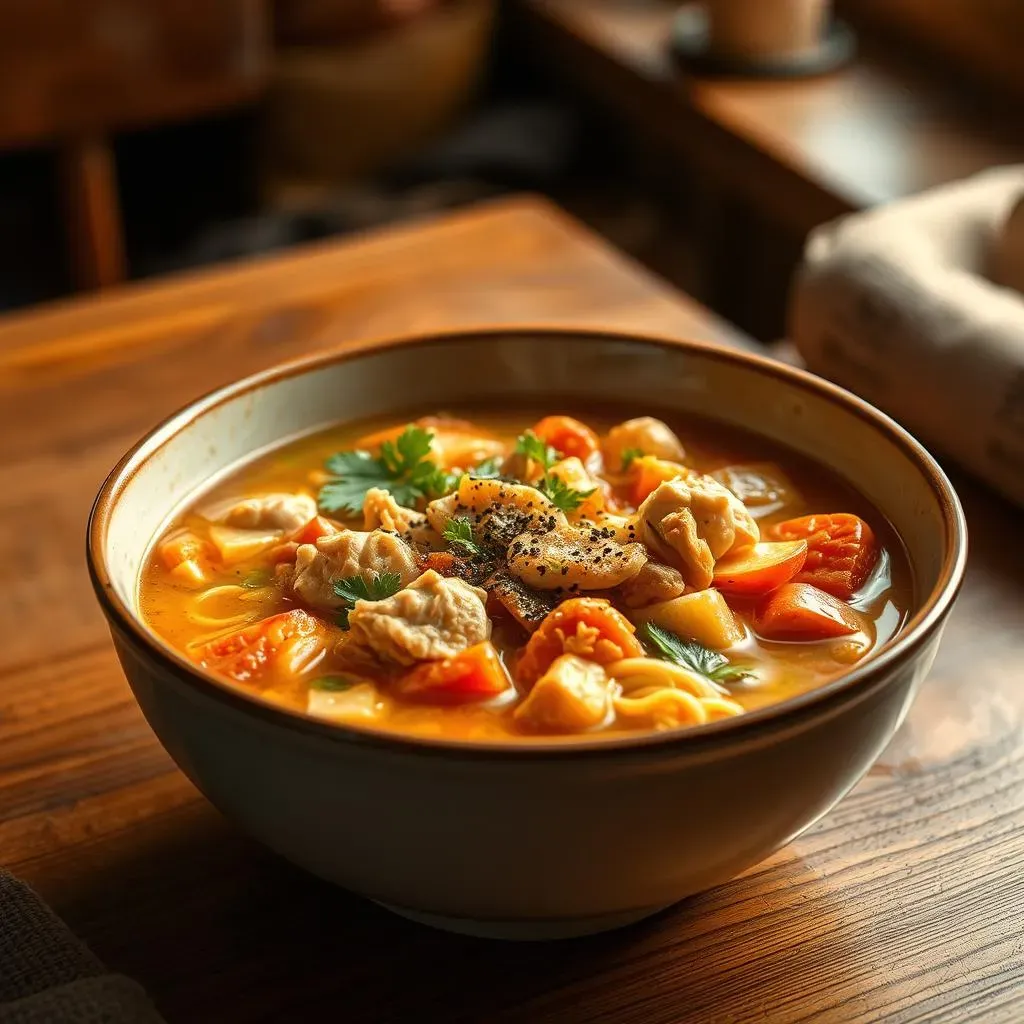Table of Contents
Is there anything more comforting than a steaming bowl of homemade chicken noodle soup? Especially when you’re feeling under the weather, or just need a little pick-me-up, this classic dish hits the spot. But making truly *great* homemade chicken noodle soup with vegetables isn't just about throwing ingredients into a pot; it's about building layers of flavor and creating a culinary masterpiece. This article will guide you through the process, step-by-step, from crafting the perfect broth to choosing the ideal vegetable companions and noodles. We'll explore how to make a homemade chicken noodle soup with vegetables that's bursting with flavor and leaves you feeling warm and satisfied. Get ready to unlock the secrets to a truly exceptional bowl of comfort food! We'll cover everything from creating a rich and flavorful broth to selecting the perfect vegetables and noodles to achieving noodle nirvana. We'll even share some fun variations to keep your soup game exciting. Get ready to elevate your soup-making skills to the next level – let's dive in!
The Best Broth: Building Flavor from Scratch

The Best Broth: Building Flavor from Scratch
Starting with the Basics: Chicken is King
The foundation of any amazing chicken noodle soup is, of course, the broth. Forget those bland, store-bought cartons! We're going for rich, flavorful homemade goodness. The secret? Start with a whole chicken – bone-in, skin-on is best. This provides collagen and fat that will render into the broth, creating that luxurious mouthfeel and depth of flavor you crave. Think of it as a flavor bomb waiting to explode! Don’t have a whole chicken? No problem! You can still make a fantastic broth using leftover roasted chicken or even frozen chicken, but using a whole chicken will give you the richest flavor. Check out our guide on making broth from bone-in chicken for more details.
Once you've got your chicken, we'll add aromatics to the pot. We're talking onions, carrots, and celery – the holy trinity of soup-making. These vegetables contribute a subtle sweetness and savory base, complementing the chicken beautifully. Don't be afraid to experiment! A bay leaf or two adds a lovely herbal note, while a few peppercorns provide a gentle warmth. And for a truly decadent broth, consider adding a sprig of thyme or rosemary. For a quicker option, try our quick chicken noodle soup recipe.
Ingredient | Purpose |
|---|---|
Whole Chicken | Rich flavor and collagen |
Onions, Carrots, Celery | Sweetness and savory base |
Bay Leaf, Peppercorns | Herbal and spicy notes |
Simmering to Perfection: Patience is a Virtue
Now comes the crucial part: simmering. Don't rush this! Low and slow is the name of the game. Let that chicken gently release its flavor into the water for at least an hour, or even longer if you have the time. The longer it simmers, the richer and more complex your broth will become. Think of it as a slow dance between the chicken and the vegetables, a harmonious blend of flavors. It's like creating a symphony of tastes! And remember, you can always adjust the seasonings along the way. A pinch of salt here, a squeeze of lemon there – these little touches can make all the difference.
Once your chicken is cooked through and falling off the bone, it's time to remove it from the pot. Shred the meat, reserving it for later. Strain the broth through a fine-mesh sieve to remove any solids, ensuring a crystal-clear, flavorful base for your soup. This is where your patience pays off! You'll be rewarded with a broth that's so rich and flavorful, it's practically a meal in itself. Looking for a healthier option? Check out our healthy chicken noodle soup recipe for inspiration.
- Simmer for at least 1 hour (longer is better!)
- Remove and shred the chicken
- Strain the broth for clarity
- Season to taste
Veggie Power: Choosing Your Perfect Soup Companions

Veggie Power: Choosing Your Perfect Soup Companions
The Classic Combo: Carrots, Celery, and Onions
Let's start with the tried-and-true trio: carrots, celery, and onions. These are the backbone of many a delicious chicken soup, and for good reason! Carrots bring a touch of sweetness, celery adds a subtle earthiness, and onions contribute a savory depth. They're a perfectly balanced team, working together to create a flavor profile that's both comforting and complex. Chop them roughly – no need for fancy knife skills here – and sauté them gently in a little butter or oil before adding them to your broth. This helps to release their natural sugars and intensify their flavor. Want to kick things up a notch? Try adding a bit of garlic along with the holy trinity for a pungent, aromatic boost!
Don't be afraid to experiment with the quantities of each vegetable. If you love carrots, go ahead and add a few extra! Similarly, if celery isn't your favorite, you can reduce the amount. The beauty of homemade soup is that you can tailor it to your exact preferences. For a truly unique twist, consider adding some leeks for a milder onion flavor. Or, for a heartier soup, try adding some diced potatoes or parsnips. For a simpler approach, check out this easy recipe that's perfect for beginners.
- Carrots: Sweetness
- Celery: Earthiness
- Onions: Savory depth
Beyond the Basics: Exploring Other Vegetables
While carrots, celery, and onions are a fantastic starting point, the world of soup vegetables is your oyster! Feel free to add other vegetables to create a more complex and interesting flavor profile. Green beans add a fresh, slightly sweet note, while corn kernels contribute a touch of sweetness and a pleasant texture. Spinach wilts beautifully in the hot broth, adding a vibrant green color and a boost of nutrients. For a heartier soup, try adding diced potatoes or sweet potatoes. These root vegetables add a creamy texture and a subtle sweetness that complements the chicken beautifully. For a more robust flavor, consider adding some chopped mushrooms or bell peppers. The possibilities are endless!
Remember to consider the cooking times of different vegetables. Some, like carrots and potatoes, require longer cooking times, while others, like spinach and green beans, cook much faster. Add the vegetables that need longer cooking times to the broth earlier, and then add the quicker-cooking vegetables toward the end of the cooking process. This ensures that all your vegetables are cooked perfectly, without becoming mushy or overcooked. For another variation, check out our recipe for homemade chicken noodle soup with various vegetables.
Vegetable | Flavor Profile | Cooking Time |
|---|---|---|
Green Beans | Fresh, slightly sweet | Short |
Corn | Sweet | Short |
Spinach | Mild, slightly earthy | Short |
Potatoes | Earthy, slightly sweet | Long |
Sweet Potatoes | Sweet | Long |
Seasonal Selections: Embracing the Harvest
One of the best things about homemade chicken noodle soup is its versatility. You can adapt the vegetables you use based on what’s in season. In the summer, consider adding fresh tomatoes, zucchini, or summer squash. These vegetables will add a burst of freshness to your soup. In the fall, try incorporating butternut squash, pumpkin, or Brussels sprouts for a warm, autumnal flavor. And in the winter, root vegetables like parsnips, turnips, and rutabagas are a perfect addition. Using seasonal ingredients not only enhances the flavor of your soup but also supports local farmers and reduces your environmental impact.
Don't be afraid to experiment with different combinations of vegetables. The more you experiment, the more you'll discover your own unique and delicious variations. Perhaps you'll create a signature soup that becomes a family favorite! And if you're looking for a simple, yet flavorful option, try using a pre-made mirepoix blend, which typically consists of diced carrots, celery, and onions. This is a great time-saver for busy weeknights. For a step-by-step guide, you can check out our step-by-step recipe.
Noodle Nirvana: Finding the Perfect Pasta for Your Pot

Noodle Nirvana: Finding the Perfect Pasta for Your Pot
The Classic Egg Noodle: A Timeless Choice
Let's talk noodles! For many, the quintessential chicken noodle soup noodle is the classic egg noodle. These broad, flat noodles have a satisfying chewiness that holds up beautifully in the broth. They soak up the flavor of the soup beautifully, creating a symphony of textures and tastes in every bite. Their simple nature allows the other flavors to shine, making them the perfect blank canvas for your delicious broth and vegetables. Plus, they're readily available in most grocery stores, making them a convenient choice for your next soup-making adventure. For a truly authentic experience, consider making your own egg noodles from scratch! It’s easier than you think, and the results are incredibly rewarding. Check out our recipe for homemade egg noodles to get started.
But don't limit yourself to just egg noodles! There's a whole world of pasta out there waiting to be explored in your soup. Consider using smaller egg noodles for a lighter, more delicate soup, or opt for wider noodles for a heartier, more substantial meal. Experiment with different shapes and sizes to find your perfect match. Or, if you're feeling adventurous, try using a different type of pasta altogether. Small pasta shapes like ditalini or acini de pepe add a fun textural element, while orzo provides a slightly chewier texture.
- Egg Noodles: Classic choice, satisfying chew
- Small Egg Noodles: Lighter soup
- Wider Egg Noodles: Heartier soup
- Ditalini/Acini de Pepe: Fun texture
- Orzo: Chewier texture
Beyond the Egg: Exploring Other Noodle Options
If you're looking for something a bit different, there are plenty of other noodle options to explore. For a gluten-free option, try using rice noodles or quinoa noodles. These noodles offer a slightly different texture and flavor profile compared to traditional egg noodles, but they still work beautifully in chicken noodle soup. Rice noodles tend to be softer and more delicate, while quinoa noodles have a slightly nutty flavor and a chewier texture. For a truly unique experience, consider using different types of Asian noodles like thin egg noodles, udon, or ramen noodles. These noodles offer a different texture and flavor profile that could transform your soup into a whole new culinary adventure.
Remember to always check the cooking instructions for your chosen noodles. Some noodles cook much faster than others, so it's important to add them to the soup at the appropriate time to prevent overcooking. Overcooked noodles will become mushy and unpleasant, so pay close attention to the cooking time. Adding the noodles towards the end of the cooking process usually ensures they're cooked perfectly, while still retaining their texture. For a quick and easy meal, consider using our 30-minute chicken noodle soup recipe.
Noodle Type | Texture | Flavor Profile | Dietary Considerations |
|---|---|---|---|
Egg Noodles | Chewy | Mild | Contains gluten |
Rice Noodles | Soft, delicate | Mild | Gluten-free |
Quinoa Noodles | Chewy, slightly nutty | Nutty | Gluten-free |
Noodle Considerations: Texture and Cooking Time
When choosing noodles for your soup, consider the texture you're aiming for. Do you prefer a chewy noodle, a delicate noodle, or something in between? The texture of the noodle will greatly impact the overall eating experience. A chewier noodle will provide a more substantial mouthfeel, while a more delicate noodle will melt away in your mouth. The cooking time of the noodles is also a crucial factor to consider. Some noodles cook much faster than others. Always check the package instructions to determine the appropriate cooking time for your chosen noodles. Adding the noodles too early can lead to mushy noodles, while adding them too late can leave them undercooked.
Finally, think about the overall flavor profile of your soup. Do you want the noodles to be a subtle background element, or do you want them to be a more prominent feature? The flavor of the noodles can complement or contrast with the other ingredients in your soup. For instance, if you’re using bolder vegetables, you might prefer a milder noodle. Conversely, if you have a milder broth, a more flavorful noodle might be a good choice. Consider this recipe using rice noodles for a lighter option.
Beyond the Basics: Tips, Tricks, and Delicious Variations

Beyond the Basics: Tips, Tricks, and Delicious Variations
Spice it Up: Flavor Boosters for Your Broth
Let's talk about elevating your soup beyond the basics. A dash of soy sauce or fish sauce adds a savory umami punch that takes your broth to the next level. Similarly, a squeeze of fresh lemon juice brightens the flavors and adds a delightful acidity that cuts through the richness of the chicken. For a touch of heat, add a pinch of red pepper flakes or a dash of your favorite hot sauce. Don't be afraid to experiment! Taste as you go and adjust the seasonings to your liking. A little goes a long way, so start with small amounts and add more as needed. For a deeper flavor, consider adding a spoonful of tomato paste to the broth while it's simmering. This will add a rich depth and complexity to your soup. For a healthier option, check out our healthy recipe.
Another simple way to add depth is to use a good quality chicken stock instead of just water. Homemade stock, of course, is best, but even a high-quality store-bought version can make a difference. If you're short on time, using a rotisserie chicken can significantly reduce prep time. Simply shred the meat and add it to your broth, along with the vegetables and noodles. For a complete guide on using rotisserie chicken, see our rotisserie chicken recipe.
- Soy sauce/fish sauce: Umami boost
- Lemon juice: Bright acidity
- Red pepper flakes: Heat
- Tomato paste: Rich depth
Creamy Dreamy: Adding a Luxurious Touch
For a richer, creamier soup, stir in a splash of heavy cream or half-and-half just before serving. This adds a luxurious texture and a velvety smoothness that elevates the soup to a whole new level. It's a simple addition, but it makes a big difference in the overall taste and feel. If you're watching your calories, you can use a lower-fat milk alternative instead. For a dairy-free option, consider using coconut milk for a unique twist on a classic dish. This will add a creamy texture and a subtle coconut flavor that pairs surprisingly well with the chicken and vegetables. If you want to make your soup even richer, you can whisk in a tablespoon of cornstarch mixed with cold water before adding the cream. This will thicken the soup and give it a more luxurious texture. For a different approach, try our coconut milk recipe.
To make your soup even more interesting, consider adding some fresh herbs at the very end. Fresh parsley, dill, or chives add a beautiful pop of color and a fresh, herbaceous aroma. A sprinkle of fresh thyme or rosemary can also add a lovely herbal note. If you have some leftover cooked chicken, you can easily incorporate it into your soup. Simply shred the chicken and add it to the pot during the last few minutes of cooking. This will ensure the chicken remains tender and juicy. For a step-by-step guide, see our step-by-step instructions.
Addition | Effect |
|---|---|
Heavy cream/half-and-half | Creamy texture |
Coconut milk | Creamy texture, subtle coconut flavor |
Cornstarch slurry | Thickens the soup |
Fresh herbs | Flavor, aroma, color |
Global Inspirations: Beyond the Classic
Don't be afraid to experiment with different flavor profiles! Add a Mexican twist with some diced jalapeños, corn, and cilantro. Or, go Italian with some sun-dried tomatoes, fresh basil, and a sprinkle of Parmesan cheese. For an Asian-inspired soup, try adding some ginger, soy sauce, and sesame oil. The possibilities are endless! Let your imagination run wild and create your own unique and delicious variations. Each addition will transform your soup into a completely new culinary experience. Experimenting with different flavors is a great way to personalize your soup and make it your own. For a different approach, try our turkey version.
Remember, the best chicken noodle soup is the one you enjoy the most! So don't be afraid to get creative and experiment with different ingredients and flavors until you find your perfect bowl of comfort. And don't forget to share your creations with friends and family. Homemade chicken noodle soup is a dish best shared, especially with loved ones. For a quick and easy option, check out our quick recipe.
